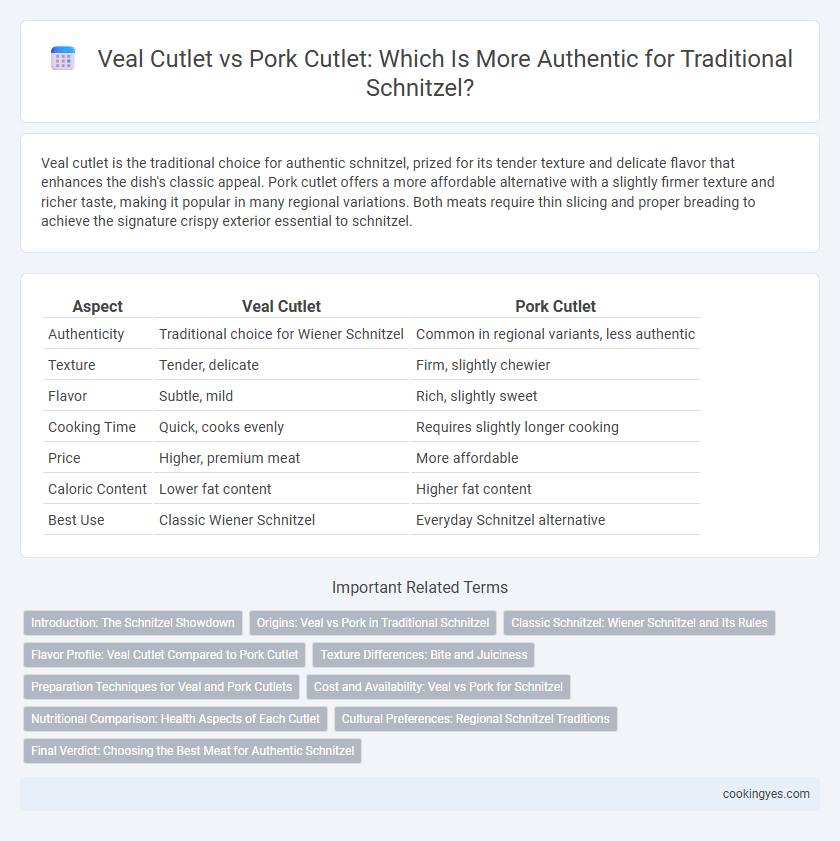Veal cutlet is the traditional choice for authentic schnitzel, prized for its tender texture and delicate flavor that enhances the dish's classic appeal. Pork cutlet offers a more affordable alternative with a slightly firmer texture and richer taste, making it popular in many regional variations. Both meats require thin slicing and proper breading to achieve the signature crispy exterior essential to schnitzel.
Table of Comparison
| Aspect | Veal Cutlet | Pork Cutlet |
|---|---|---|
| Authenticity | Traditional choice for Wiener Schnitzel | Common in regional variants, less authentic |
| Texture | Tender, delicate | Firm, slightly chewier |
| Flavor | Subtle, mild | Rich, slightly sweet |
| Cooking Time | Quick, cooks evenly | Requires slightly longer cooking |
| Price | Higher, premium meat | More affordable |
| Caloric Content | Lower fat content | Higher fat content |
| Best Use | Classic Wiener Schnitzel | Everyday Schnitzel alternative |
Introduction: The Schnitzel Showdown
Authentic schnitzel traditionally features veal cutlets known for their tender texture and delicate flavor, making Wiener Schnitzel a classic Austrian specialty. Pork cutlets serve as a popular alternative, offering a slightly richer taste and more affordable option while still maintaining the crispy, golden-brown crust characteristic of schnitzel. The choice between veal and pork cutlet significantly influences the dish's authenticity, flavor profile, and culinary heritage.
Origins: Veal vs Pork in Traditional Schnitzel
Traditional schnitzel originated in Austria, where the authentic Wiener Schnitzel is made exclusively from veal cutlet, prized for its tender texture and delicate flavor. In contrast, pork cutlet is widely used in German and other regional schnitzel variations due to its affordability and slightly richer taste. The choice between veal and pork reflects cultural and economic differences, with veal representing the classic Viennese standard and pork offering a popular, accessible alternative.
Classic Schnitzel: Wiener Schnitzel and Its Rules
Wiener Schnitzel is traditionally made with veal cutlet, which ensures the dish's authentic taste and tender texture, a critical factor for preserving its classic status in Austrian cuisine. Pork cutlet, while commonly used in variations and more affordable versions, does not meet the stringent criteria specified by traditional Wiener Schnitzel regulations, which emphasize veal as the exclusive meat. The distinction between veal and pork cutlets directly impacts the flavor profile, authenticity, and legal protection of the Wiener Schnitzel name under Austrian culinary heritage.
Flavor Profile: Veal Cutlet Compared to Pork Cutlet
Veal cutlet offers a tender texture and delicate, mildly sweet flavor that defines authentic Wiener Schnitzel, while pork cutlet has a richer, slightly fattier taste with a more pronounced meatiness. The subtle, buttery notes of veal complement the light, crispy breading without overwhelming it, maintaining the classic taste balance. Pork cutlet's robust flavor can overshadow the traditional schnitzel profile but appeals to those seeking a heartier variation.
Texture Differences: Bite and Juiciness
Veal cutlet offers a tender, delicate texture with a fine grain that delivers a subtle bite and moderate juiciness, making it ideal for authentic Wiener Schnitzel. Pork cutlet, by contrast, has a slightly firmer texture and denser meat fibers, resulting in a more robust bite and increased juiciness due to higher fat content. These textural differences influence the overall mouthfeel and richness of the schnitzel, with veal providing a lighter, more refined experience and pork offering heartier, more flavorful satisfaction.
Preparation Techniques for Veal and Pork Cutlets
Preparation techniques for authentic veal schnitzel emphasize thinly pounding the veal cutlet to ensure tenderness and quick, even cooking, often seasoned simply with salt and pepper before dredging in flour, egg wash, and fine breadcrumbs. Pork cutlets, typically thicker, require careful pounding to a uniform thickness to prevent toughness and are sometimes marinated to enhance flavor, following the same classic breading process but cooked slightly longer to guarantee thorough doneness. Both veal and pork schnitzels rely on maintaining proper oil temperature during frying, around 160-170degC (320-340degF), to achieve a golden-brown crust without absorbing excess oil.
Cost and Availability: Veal vs Pork for Schnitzel
Veal cutlets for schnitzel tend to be more expensive and less readily available compared to pork cutlets, which are widely accessible and more budget-friendly. Pork cutlets offer a cost-effective alternative while maintaining a tender texture suitable for traditional schnitzel preparation. The higher price and limited supply of veal often make pork the preferred choice for authentic schnitzel in many households and restaurants.
Nutritional Comparison: Health Aspects of Each Cutlet
Veal cutlet used in authentic schnitzel is leaner, lower in fat, and provides more protein per serving compared to pork cutlet, making it a healthier option for those focused on muscle maintenance and weight control. Pork cutlet contains higher levels of saturated fat and calories, which may impact heart health negatively if consumed frequently. While both offer essential nutrients like B vitamins and minerals, veal schnitzel aligns better with a balanced diet emphasizing lower fat intake.
Cultural Preferences: Regional Schnitzel Traditions
Veal cutlet, traditionally used in Austrian Wiener Schnitzel, represents authentic regional preferences emphasizing tenderness and delicate flavor. Pork cutlet dominates in German and Central European variations, reflecting local affordability and heartier taste profiles. These cultural distinctions highlight how regional schnitzel traditions influence meat selection and culinary identity.
Final Verdict: Choosing the Best Meat for Authentic Schnitzel
Veal cutlet offers a tender texture and delicate flavor, making it the traditional choice for an authentic Wiener Schnitzel, while pork cutlet provides a slightly richer taste and firmer bite often favored for cost-effective variations. Authenticity in schnitzel strongly leans towards veal due to its historical and regional roots in Austrian cuisine. Selecting veal ensures adherence to classic standards, whereas pork serves as a popular substitute balancing flavor and affordability.
Veal cutlet vs Pork cutlet for authentic schnitzel Infographic

 cookingyes.com
cookingyes.com